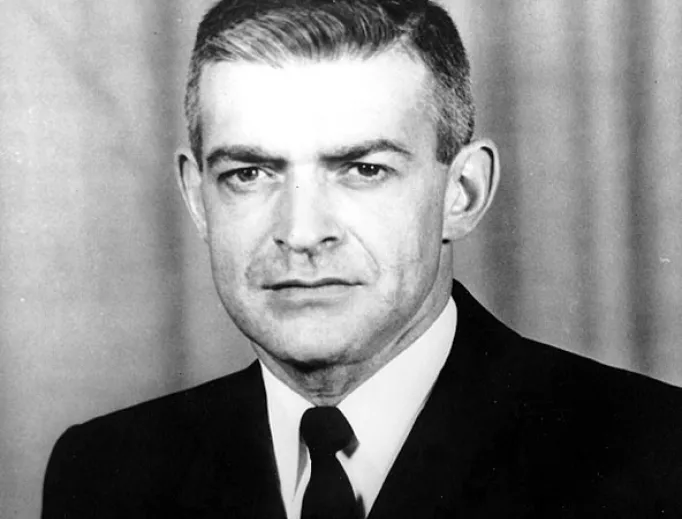While the sainthood cause for the Grunt Padre, Father Vincent Capodanno - who died from 27 bullet wounds on a Vietnam battlefield as a military chaplain to U.S. Marines is experiencing a snag since Consultants to the Vatican body tasked with judging possible saints have recommended the suspension of Capodanno’s cause, the process is illustrative of the Devil's Advocate: The Devil's Advocate is a Church's construct. In the early days of Christianity, local communities would determine who was a saint, post mortem. To better authenticate the canonization, the Church at around 1450 devised a position known as Diaboli Advocatus - Devil's Advocate. The Devil's Advocate job was to cast doubt on the virtues and miracles reported when a holy man or woman was brought to the pope to be recognized as a saint. Sort of what the New York Times does today.
The Church knew that miracles can often be confused with other things, and that, unfortunately, fallen humans sometimes make up stories for the purposes of fame or attention. She also knew that demons have certain powers that can make certain things appear miraculous. The Church has also developed a protocol to validate miraculous occurrence, focusing on those that have public repercussions, such as the miraculous healings attributed to the saints that, if validated, will advance their cause for canonization. Eucharistic miracles are another form of miracle that often warrants her attention, since they draw venerators and it is important to ensure that the miracle is authentic.
In all these investigations, the Church is careful, not only using a Devil's Advocate but also doctors, scientists, and competent authorities in order to rule out natural explanations or to understand the phenomenon better. Only when she has completed this stringent process does she validate the miracle. In response to my piece celebrating the Unsung American Heroines during the recent International Women’s Day, Norinda Rosario Yancey has this to say about Saint Mother Teresa “I would recommend reading a little more about Mother Teresa. She was quite troubled emotionally and spiritually. Though morbid, there is speculation based on her writings that she was oddly fascinated and may have even taken some pleasure in witnessing the starvation and illness of those she is said to have cared for. It’s fascinating really, but I no longer regard her as a hero.” Yancey describes herself as an educator and a Metro Parks Tacoma, Washington employee and a JEDAI |
| Servant of God Father Vincent Capodanno died shielding a fellow Marine. He died from 27 bullet wounds. (photo: Public domain / Public domain) |
Meanwhile, Vincent Robert Capodanno was born on Staten Island, New York, to Italian immigrant parents. In 1957, he was ordained a Catholic priest by Cardinal Francis Spellman, then vicar of the U.S. Military Ordinariate. He entered the Maryknoll religious order and served as a missionary in Taiwan and Hong Kong from 1958 to 1965. After he successfully petitioned his Maryknoll superiors to release him to serve as a U.S. Navy chaplain. In Vietnam, he held the rank of lieutenant and took part in seven combat operations. During the Operation Swift campaign, Father Capodanno was injured by an exploding mortar round that caused multiple injuries to his arms and legs and severed part of his right hand. He continued to tend to the wounded and nearly lost his hand to shrapnel. Despite his wounds, he refused care so that medical supplies could go to his injured Marines.The priest directed Marines to help the wounded and continued to move about the battlefield, encouraging them with his words and example. While seeking to aid one particular Marine, he put his own body between the wounded man and an enemy machine gunner who opened fire. He died from 27 bullet wounds. He was posthumously awarded the Congressional Medal of Honor, the Navy Bronze Star medal, the Vietnamese Cross of Gallantry with Silver Star, and the Purple Heart Medal.
In May, an advisory panel of theological consultants considered the positio document prepared by the postulator and its arguments in favor of and against Father Capodanno’s beatification. In the Catholic Church, a positio is a document or collection of documents used in the process by which a person is declared Venerable, the second of the four steps on the path to canonization as a saint. The consultants voted to recommend to the dicastery that Father Capodanno’s cause be suspended. At the Vatican, the Dicastery for the Causes of Saints is responsible for canonization decisions. The piece by Kevin J. Jones titled, Sainthood Cause for Father Vincent Capodanno Sees Setback illustrates the Devil's Advocate position for Father Grunt, as well as that of his supporters and concludes that Fagther Grunt's "supporters remain hopeful that an appeal will resume the efforts
No comments:
Post a Comment